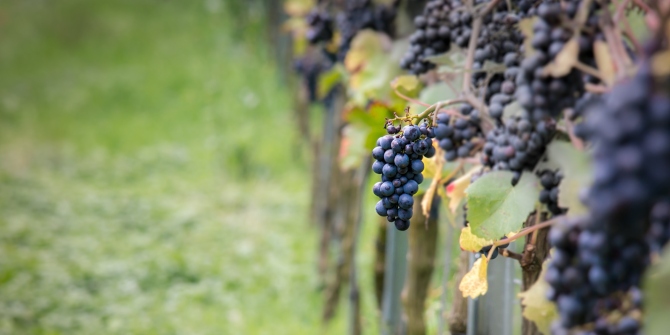
Frequently described as the ‘the canary in the coalmine’ of global agriculture, wine grapes are exceptionally climatically sensitive and grow at their best only within narrow climatic bands – typically between 13 and 21°C. Warmer climates have brought a larger area of the UK within the ideal climatic range for a number of commercially popular wine grape varieties, including several that have defined some of the finest wine regions in France. Indeed, the Chardonnay and Pinot Noir grapes, two of the primary cultivars used in the production of champagne, have dominated recent UK production and constituted 61.7 per cent of new vine plantings in 2017.
Much excitement surrounds the sector. It is growing quickly, with demand outstripping supply. Vineyards now cover around 2,500 hectares, an increase of 246 per cent on 2004 levels. English sparkling wines, which accounted for 68 per cent of UK wine production in 2017, have gained international recognition, winning a number of prestigious international awards for their distinctive bright and fresh cool-climate acidity. And alongside French champagne producers acquiring growing sites on UK soil (Taittinger in Kent and Vranken-Pommery in Hampshire), a number of notable British brands have emerged, including from the Nyetimber, Camel Valley, Ridgeview and Chapel Down Estates.
Last year was labelled the “harvest of the century”, as favourable climatic conditions led to many growers reporting unprecedented harvests. Commentators have been particularly excited that this very strong vintage may have enabled producers to build reserves for less abundant years, to support reliable supply and to upscale development of the sector.
Climate-related advantages over Old and New World producers
Alongside warming growing-season temperatures, there are other reasons for UK viticulture to be optimistic, especially when compared with many of the more established wine-growing regions globally.
Cooler climates provide grapes with more time to mature
Firstly, cooler climates like the UK’s typically allow for a longer ripening period, giving fruit time to mature with complexity and depth. Indeed, grapes grown in areas that are close to the limits of where they can successfully ripen are known to produce some of the most interesting wines. In contrast, the signature tastes of some classic wine regions are thought to be under threat not only from increasing climatic extremes, changing crop-disease profiles and heightened risk of fires, droughts, floods and storms, but also from warmer temperatures advancing the timing of grape development stages.
Many of the world’s major traditional wine regions are located in areas that experience average growing season temperatures that already exceed optimum levels for the grape varieties they are best known for. In California’s Napa Valley, for example, higher growing season temperatures are frequently forcing early harvests, to preserve the acidity levels that support wine quality and ageing potential, or to control alcohol concentrations. Even subtle changes in the duration of the growing season or alcohol content can have consequences for a wine’s depth, balance and characteristic expression.
Freedom to define tastes
Secondly, while viticulture tastes and terroirs – defined by environmental factors shaping wine-making – have always evolved, UK producers remain relatively uninhibited by the existing typologies that define their more established and historically rooted counterparts in Continental Europe. Especially in Old World viticulture, wine production is intertwined with deep-seated attachments to place and cultural heritage, which limits growers’ ability to adapt production to changing climatic conditions. Brands and regions are often built around traditional soil, topography and variety pairings, which, alongside their associated typicities, have been concretised in protected geographical designations and appellations of origin.
A region’s wine-growing identity is often determined by one, or a very small number of cultivars – consider, for example, the importance of the Sangiovese grape to the Chianti and Brunello di Montalcino wines of Tuscany. And fine-wine producers, especially, often trade on their wine as an ancestral art spanning generations, with a brand hinging on a distinctive, characteristic and geographically situated terroir. Such brands may not be easily reconciled with a change of primary cultivar to one with attributes more adaptive to a changing climate, or with relocating vineyards to higher altitudes or latitudes in response to changing climatic conditions. In contrast, UK producers operating within a young and less established production landscape are arguably freer to define the tastes and styles of their wines to maximise the current – and future – opportunities presented by a changing climate.
More control, from using chaptalization
Thirdly, for as long as latitude provides sufficient protection to grapes from conditions related to extreme heat or sunburn, English and Welsh wine-makers may start to possess greater flexibility and control over the alcohol levels and flavours of their wine than their European counterparts, through the use of chaptalisation. This process involves adding sugar prior to grape fermentation to enhance and control the alcoholic content of a wine. Chaptalisation has been common in many cooler regions. Yet some European producers have discontinued this practice as a result of rising natural sugar levels within their grapes from hotter growing seasons. This means that, in some senses, these producers have lost a degree of control within their production process. In the UK, meanwhile, chaptalisation remains common.
Less water resource pressure
Finally, where warming climates are contributing to the need for irrigation among more and more of the existing planted vineyards globally, almost no UK producers currently irrigate their land. Under a changing climate, the viability of dry-farming in UK viticulture may be greater than in other longer established wine-growing regions. This is significant given the vast water footprint of irrigated viticulture: a footprint that has led climate change and viticulture commentator Linda Johnson Bell to argue that, in an increasingly water-stressed world, climate justice requires that dry farming should become the new sustainability standard for this inescapably ‘luxury’ crop.
Building future climate resilience into UK viticulture now
Despite these opportunities for the English and Welsh wine sector, production is likely to remain precarious and subject to the vagaries of heightened climate risk as a result of climate change. Like the rest of the world, the UK is experiencing and expecting more extremes and greater variability in weather and climate than before. The strong 2018 UK vintage highlighted that, along the margins of viticulture suitability, deviations from ‘normal’ growing conditions can produce opportunities. Yet the extremes that emerge from anthropogenic climate change are also likely to regularly exceed those that allow vines in the UK to produce their optimum fruit. From threats such as heightened frost risk (arising from earlier bud-burst leaving vines vulnerable to spring frosts), to disrupted growing seasons, erratic production and frequent high losses are likely.
Lessons should be learnt from the many Old and New World modern commercial vineyards that are experiencing heightened climatic vulnerabilities from failing to account for climate change within planting decisions: for example through increased planting of more commercially popular, but less adaptive and less heat- and drought-tolerant varieties, such as Tempranillo. Instead, UK producers should be accounting for climate change adaptation in the design and development of the sector as it grows, choosing the best sites and soils for planting, and pairing these with the right grape varieties. It takes at least three years until a new vine produces fruit, with dry-farmed vines often taking much longer to come into production and fine wines often produced from vines many decades old. This highlights the importance of informed long-term decision-making. And with rising investment and more land coming under production all the time, these are decisions that the UK viticulture sector needs to get right now.
| The CREWS-UK (Climate Resilience in the UK Wine Sector) project is working to support climate change adaptation decision-making to build resilience within the sector. Over the coming year, our research team will capitalise on the launch of new UK Met Office climate projections (UKCP18) toanalyse how climatic trends and variability may influence the UK wine production sector and to identify pathways to support long-term economic sustainability. CREWS-UK is a partnership between climatologists, wine sector specialists and social scientists from the Grantham Research Institute, the University of East Anglia, Weatherquest and VinescapesVinescapes. This work is supported by UK Research and Innovation SPF UK Climate Resilience programme [grant reference number NE/S016848/1]. Read more about the project here. |
Also by Kate Gannon:
As Southern Africa faces new urban drought challenges, who is heeding the wake-up call?
♣♣♣
Notes:
- This blog post appeared first with the title For sustainable growth in the UK’s wine-producing industry, climate change must be integrated into sector planning now on the site of LSE’s Grantham Research Institute on Climate Change and the Environment.
- The author would like to thank Alistair Nesbitt (Vinescapes) and Steve Dorling (Weatherquest) for contributing ideas to this commentary. Any inaccuracies remain her own.
- The post gives the views of its author, not the position of LSE Business Review or the London School of Economics.
- Featured image by Didgeman, under a Pixabay licence
- Before commenting, please read our Comment Policy
 Kate Elizabeth Gannon is a postdoctoral researcher in the Sustainable Development team at LSE’s Grantham Research Institute on Climate Change and the Environment. She has a background in human geography and science and technology studies and pursues interdisciplinary and problem-focused research that explores the interactions and relationship between climate and society. Currently, Kate’s research is particularly focused on social and institutional dimensions of climate change adaptation at multiple scales, including in sub-Saharan Africa and among private sector actors.
Kate Elizabeth Gannon is a postdoctoral researcher in the Sustainable Development team at LSE’s Grantham Research Institute on Climate Change and the Environment. She has a background in human geography and science and technology studies and pursues interdisciplinary and problem-focused research that explores the interactions and relationship between climate and society. Currently, Kate’s research is particularly focused on social and institutional dimensions of climate change adaptation at multiple scales, including in sub-Saharan Africa and among private sector actors.





